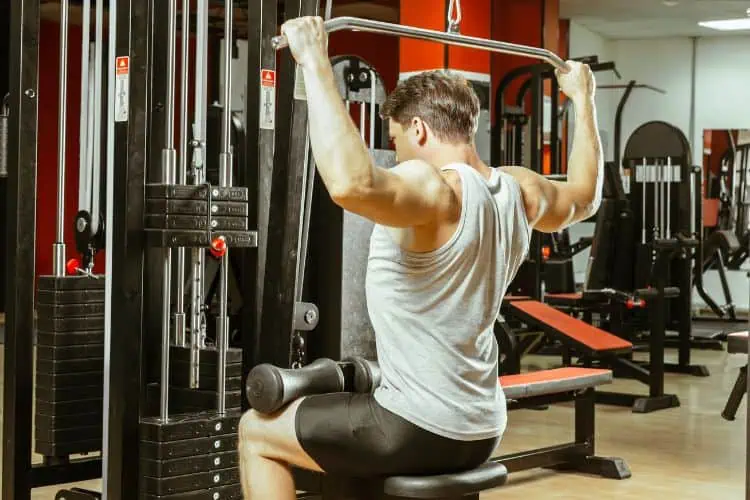
When it comes to building a strong, muscular, and well-defined back, vertical pull exercises are a cornerstone of any effective training program. These exercises target the latissimus dorsi (lats), trapezius, rhomboids, and other key muscles in the upper body, helping you develop a V-shaped torso, improve posture, and enhance overall strength. Whether you’re a beginner or an advanced lifter, understanding and incorporating vertical pull exercises into your routine can take your fitness journey to the next level.
In this comprehensive guide, we’ll dive deep into the world of vertical pull exercises, exploring their benefits, the muscles they work, and how to perform them with proper form. We’ll also provide tips for optimizing your workouts and avoiding common mistakes. Let’s get started!
What Are Vertical Pull Exercises?
Vertical pull exercises are movements where you pull a weight or your body vertically downward, typically toward your chest or shoulders. These exercises are performed in a vertical plane of motion, meaning the movement occurs up and down rather than horizontally. Examples include pull-ups, lat pulldowns, and chin-ups.
These exercises are essential for developing upper body strength, particularly in the back, shoulders, and arms. They also engage the core and improve grip strength, making them a versatile addition to any workout routine.
Benefits of Vertical Pull Exercises
1. Build a Stronger, Wider Back
Vertical pull exercises are unparalleled when it comes to targeting the lats, the large muscles that give your back its width. By consistently performing these exercises, you can develop a broader, more muscular back that enhances your overall physique.
2. Improve Posture
Many vertical pull exercises engage the muscles responsible for maintaining proper posture, such as the rhomboids and lower traps. Strengthening these muscles can help counteract the effects of slouching and sitting for long periods.
3. Enhance Upper Body Strength
Vertical pulls are compound movements, meaning they work multiple muscle groups simultaneously. This makes them highly effective for building overall upper body strength, including the biceps, forearms, and shoulders.
4. Boost Functional Fitness
The pulling motion used in vertical pull exercises mimics real-world movements like climbing or lifting objects overhead. By improving your strength in this plane of motion, you’ll enhance your ability to perform daily activities with ease.
5. Increase Grip Strength
Many vertical pull exercises require a strong grip to hold onto a bar or handles. Over time, this can lead to significant improvements in grip strength, which is beneficial for other lifts like deadlifts and rows.
Key Muscles Worked in Vertical Pull Exercises
Understanding the muscles involved in vertical pull exercises can help you maximize their effectiveness and ensure you’re targeting the right areas. Here are the primary muscles worked:
1. Latissimus Dorsi (Lats)
The lats are the largest muscles in the back and are primarily responsible for the pulling motion in vertical pull exercises. They play a key role in shoulder extension, adduction, and internal rotation.
2. Trapezius (Traps)
The traps are divided into upper, middle, and lower sections. Vertical pull exercises primarily engage the middle and lower traps, which help stabilize the shoulder blades and support proper posture.
3. Rhomboids
Located between the shoulder blades, the rhomboids assist in retracting and stabilizing the scapulae during vertical pulls. Strong rhomboids contribute to better posture and shoulder health.
4. Biceps Brachii
The biceps are secondary muscles in vertical pull exercises, assisting in elbow flexion as you pull your body or the weight toward you.
5. Forearms
Your forearms play a crucial role in grip strength during vertical pull exercises. Over time, these muscles will become stronger and more defined.
Top Vertical Pull Exercises to Add to Your Routine
Now that you understand the benefits and muscles worked, let’s explore some of the best vertical pull exercises you can incorporate into your workouts.
1. Pull-Ups
Pull-ups are one of the most effective bodyweight exercises for building upper body strength. They primarily target the lats but also engage the biceps, traps, and core.
How to Perform:
- Grab a pull-up bar with an overhand grip, hands slightly wider than shoulder-width apart.
- Hang with your arms fully extended and engage your core.
- Pull your body upward until your chin clears the bar.
- Lower yourself back to the starting position with control.
Pro Tip: If you’re new to pull-ups, use a resistance band for assistance or perform negative pull-ups (focusing on the lowering phase) to build strength.
2. Chin-Ups Vertical Pull Exercises
Chin-ups are similar to pull-ups but use an underhand grip, which places more emphasis on the biceps.
How to Perform:
- Grab the bar with an underhand grip, hands shoulder-width apart.
- Hang with your arms fully extended and engage your core.
- Pull your body upward until your chin clears the bar.
- Lower yourself back to the starting position with control.
Pro Tip: Chin-ups are a great alternative if you want to focus more on arm development while still engaging your back muscles.
3. Lat Pulldown
The lat pulldown is a machine-based exercise that mimics the pull-up motion. It’s an excellent option for beginners or those who struggle with bodyweight pull-ups.
How to Perform:
- Sit at a lat pulldown machine and adjust the thigh pad to secure your legs.
- Grab the bar with an overhand grip, hands slightly wider than shoulder-width apart.
- Pull the bar down toward your chest while keeping your torso upright.
- Slowly return the bar to the starting position.
Pro Tip: Focus on squeezing your lats at the bottom of the movement to maximize muscle engagement.
4. Assisted Pull-Up Machine Vertical Pull Exercises
The assisted pull-up machine is a great tool for building strength if you’re not yet able to perform full bodyweight pull-ups.
How to Perform:
- Set the desired weight on the machine and kneel or stand on the platform.
- Grab the handles with an overhand grip.
- Pull yourself upward until your chin clears the handles.
- Lower yourself back to the starting position with control.
Pro Tip: Gradually decrease the assistance weight over time as you build strength.
5. Behind-the-Neck Pulldown
This variation of the lat pulldown targets the upper lats and traps but should be performed with caution to avoid shoulder strain.
How to Perform:
- Sit at a lat pulldown machine and grab the bar with a wide overhand grip.
- Pull the bar down behind your neck while keeping your torso upright.
- Slowly return the bar to the starting position.
Pro Tip: Only perform this exercise if you have good shoulder mobility and no history of shoulder injuries.
Tips for Optimizing Your Vertical Pull Workouts Exercises
To get the most out of your vertical pull exercises, follow these tips:
1. Focus on Full Range of Motion
Ensure you’re performing each exercise through its full range of motion to maximize muscle activation and prevent imbalances.
2. Engage Your Core With Vertical Pull Exercises
Keep your core tight throughout each movement to stabilize your body and protect your lower back.
3. Control the Eccentric Phase
The lowering phase (eccentric) of each exercise is just as important as the pulling phase. Lower the weight or your body with control to build strength and prevent injury.
4. Vary Your Grip
Experiment with different grip widths and styles (overhand, underhand, neutral) to target different muscles and keep your workouts fresh.
5. Progressive Overload
Gradually increase the weight, reps, or sets over time to continue challenging your muscles and promoting growth.
Common Mistakes to Avoid With Vertical Pull Exercises
1. Using Momentum
Avoid swinging your body or using momentum to complete reps. This reduces muscle engagement and increases the risk of injury.
2. Partial Reps
Performing partial reps limits muscle activation and can lead to imbalances. Always aim for a full range of motion.
3. Neglecting Warm-Up
Skipping a proper warm-up can increase the risk of injury. Spend 5-10 minutes warming up your shoulders, back, and arms before diving into vertical pull exercises.
4. Poor Scapular Control
Failing to retract and depress your shoulder blades during vertical pulls can lead to poor form and reduced effectiveness. Focus on scapular movement throughout each rep.
Sample Vertical Pull Workout Exercises Routine
Here’s a sample workout routine to help you incorporate vertical pull exercises into your training:
Warm-Up:
- 5-10 minutes of dynamic stretching or light cardio
- Band pull-aparts (2 sets of 15 reps)
Workout:
- Pull-Ups: 3 sets of 8-12 reps
- Lat Pulldown: 3 sets of 10-15 reps
- Chin-Ups: 3 sets of 8-12 reps
- Assisted Pull-Up Machine: 3 sets of 10-12 reps
- Behind-the-Neck Pulldown: 2 sets of 12-15 reps
Cool-Down:
- 5-10 minutes of static stretching for the back, shoulders, and arms
Vertical pull exercises are a powerful tool for building a stronger, more defined back and improving overall upper body strength. By incorporating exercises like pull-ups, chin-ups, and lat pulldowns into your routine, you can target key muscle groups, enhance your posture, and boost functional fitness. Remember to focus on proper form, progressive overload, and full range of motion to get the most out of your workouts.
Whether you’re a beginner or an experienced lifter, vertical pull exercises should be a staple in your training program. Start incorporating them today and watch your back grow stronger and more impressive with each workout!

